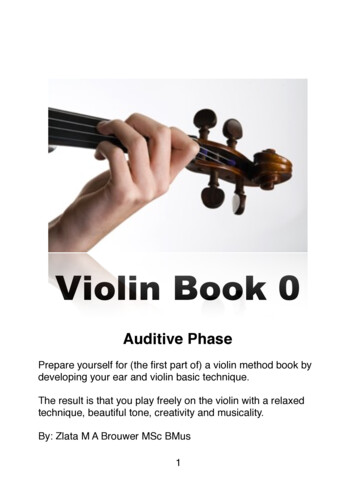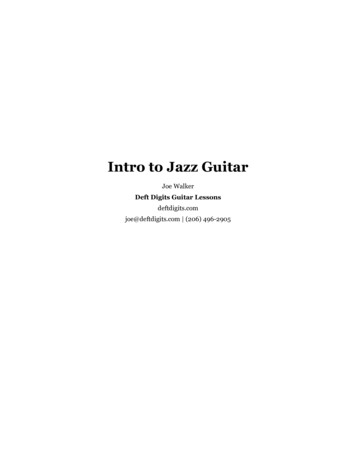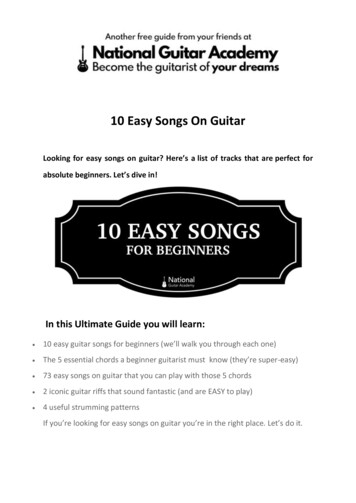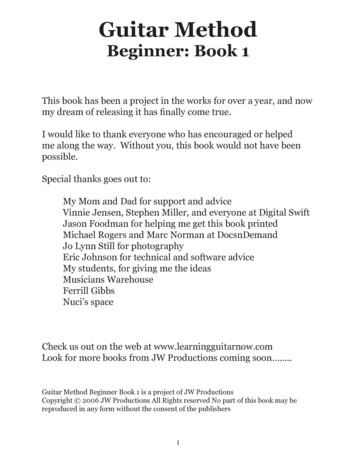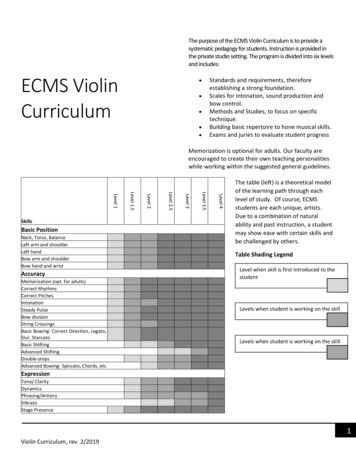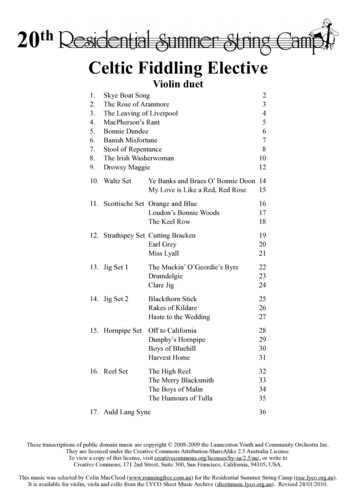
Transcription
Dept of Speech, Music and HearingACOUSTICS FORVIOLIN AND GUITARMAKERSErik JanssonChapter IV:Properties of the Violin and the Guitar StringFourth edition .pdf
Index of chaptersPreface/Chapter ISound and hearingChapter IIResonance and resonatorsChapter IIISound and the roomChapter IVProperties of the violin and guitar stringChapter VVibration properties of the wood and tuning of violin platesChapter VIThe function, tone, and tonal quality of the guitarChapter VIIThe function of the violinChapter VIIIThe tone and tonal quality of the violinChapter IXSound examples and simple experimental material – under preparationWebpage: l
ACOUSTICS FOR VIOLIN AND GUITAR MAKERSChapter 4 – Applied AcousticsPROPERTIES OF THE VIOLIN AND THE GUITAR STRINGPart 1: FUNDAMENTALS OF STRINGS4.1. Fundamental string theory4.2. Homogeneous strings4.3. Wound strings4.4. Summary4.5. Key wordsPart 2: PLAYED STRINGS AND SCALES4.6. Real strings4.7. Played string in principle4.8. Gesture of the bow and scales.4.9. Summary4.10. Key words4.11. APPENDIX: Relations frequency and tone positionJansson: Acoustics for the violin and guitarmaker 4.2
Chapter 4.APPLIED INSTRUMENT ACOUSTICS - PROPERTIES OF THE VIOLIN AND THEGUITAR STRINGFirst part: FUNDAMENTALS OF STRINGSINTRODUCTIONIn the first part of this chapter the acoustical fundamentals of the string is presented. Firstfundamental string theory is introduced, resonances, vibration sensitivity and theirrelations to mechanical properties of the string. Thereafter the properties of stringmaterials are given and finally the effects of winding on a string.4.1FUNDAMENTAL STRING THEORY (resonance, resonant frequency,bandwidth, nodes, antinodes, vibration sensitivity (mobility), tension, mass, specificspecific vibration sensitivity (specific mobility)).ACOUSTICAL PROPERTIESThe acoustical properties of a resonator can be measured in terms of vibration sensitivity(mobility). For the simple resonator a resonance curve is obtained with a peak like in Fig.4.1. The peak and the shape of the complete curve is fully determined by threemeasures, the position, the height, and the width of the peak i.e., the RESONANTFREQUENCY, the PEAK LEVEL, and the BANDWIDTH respectively, see Fig. 4.1.Often another level measure is interesting, i.e. the specific vibration sensitivity (specificmobility). The specific vibration sensitivity can often be used as a material constant. Thepeak level can be calculated from the resonant frequency, the bandwidth, and the specificvibration sensitivity. The bandwidth is also a measure of how long it takes a constantdriving force to bring the system into equilibrium. Thus the bandwidth predicts thelength of the starting transient.Figure 4.1. Acoustical properties of a resonance: vibration sensitivity response with resonance frequencyRF, bandwidth B, peak level RN and specific vibration sensitivity SV.Jansson: Acoustics for the violin and guitarmaker 4.3
Figure 4.2. Resonances of the string: modes of vibration, their nodes and antinodesThe string has several resonances, see Fig. 4.2. The vibrations are distributed in specificways. For the ideal string the resonant frequencies (the partials) are 2x, 3x, 4x, etc. thefrequency of the lowest resonance, the fundamental tone. At each resonance the stringvibrates in a different mode, see Fig. 4.2. In the lowest resonance the string has oneantinode, and nodes at its ends, in the second resonance it has two antinodes withnodes in the middle and at the ends, etc. The vibration sensitivity curve of a stringdisplays a number of peaks, see Fig. 4.3. Each peak has its own frequency, the resonantfrequency, its own bandwidth, and its own peak height. The peak height indicates thestrength of each string tone (partial, resonance) and the bandwidth indicates itsreverberation time. The specific vibration sensitivity is a measure of how the string willcooperate with the instrument.Figure 4.3. Resonances of the string: every resonance peak has its own frequency, bandwidth andpeak height.Jansson: Acoustics for the violin and guitarmaker 4.4
SPECIFIC VIBRATION SENSITIVITY - DRIVING FORCEThe specific vibration sensitivity is a fundamental measure of how sensitive a resonator, astring or a plate is to vibration forces. But, if one wants to study the sensitivity tovibrations in detail also the resonance properties such as frequency and bandwidth mustbe included.The specific vibration sensitivity (and the resonant properties) is a measure howvibrations are transferred, from a string to a violin for instance.FIGURE. 4.4. Force transfer between two resonator systems a) stiffness controlled and b) mass controlledExample 4.1: If you are standing on a thick plank and want to bend a board in the ceiling(for nailing it, see Fig. 4.4) thena) it is easy if the plank is stiff and the board soft, butb) it is difficult if the plank is soft and the board is stiff.Thus it is not only how strong you are but also the strength of the support you arepushing from that is important. If you push and pull repeatedly in the board in casea) the board will bend much and the plank little andb) the board will bend little and the plank much. (compare with the formula for specificvibration sensitivity - the stiffness corresponds to the spring in Fig. 2.8).Example 4.2: If you are pushing a small dinghy away from a yacht then the dinghy isgiven a considerable motion but the yacht a small one. If you push and pullalternatively the dinghy moves much and the yacht little. The motions areindependent of whether you are in the dinghy or in the yacht (comparewith the formula for specific vibration sensitivity - the weights of the boatscorresponds to the mass in Fig. 2.8).We can see a certain relation between the motions in the two cases, board-plank anddinghy-yacht, i.e., vibrations are efficiently transferred from a stiff plank with lowvibration sensitivity to a soft board with high vibration sensitivity. The same relationapplies to the two boats. From a heavy boat with low vibration sensitivity vibrations areefficiently transferred to a light boat with high vibration sensitivity. In the oppositedirection the transfer works inefficiently; it is difficult to transfer vibrations from anobject with high vibration sensitivity to one with low vibration sensitivity. The transfer ofJansson: Acoustics for the violin and guitarmaker 4.5
vibrations is dependent on both the force applied and the ratios of the mobilities of thetwo objects. Let us accept with the sketched background that the specific vibrationsensitivity of the transmitter and the receiver determines the vibration transfer.Example 4.3. The output connectors of the amplifier should have the same labelling asthe loudspeaker - 4 ohms to 4 ohms or 8 ohms to 8 ohms.Example 4.4: For a car motor to work efficiently an adaptation must be used - the gearbox.Example 4.5: A string has a high specific vibration sensitivity and a violin or a guitar hasa low one - thus the string will vibrate much and the violin or the guitarlittle. But the closer to equality the ratio of string vibration sensitivity tothe violin or guitar vibration sensitivity are, the more sound comes out ofthe instrument. If the mobilities are equal a "wolf tone" is obtained.MECHANICAL PROPERTIESThe properties of the simple resonator are determined by its mechanical properties, i.e.the mass (the weight), the stiffness and the total friction. For the multiresonator systemlike the string, material constants are obtained by the mass (weight) per meter of thestring, the string tension (the stiffness), and the internal friction.PRACTICAL FORMULAS FOR SMALL CHANGESIn the practical cases one chooses between different strings and thus it is interesting toestimate how different mechanical properties influence the main acoustical properties.Two simple formulas can be derived:the resonant frequency change (in percent) - length change (in percent) 1/2 x tension change (in percent) - 1/2 x mass change (in percent).the specific vibration sensitivity change (in percent) - 1/2 x tension change (inpercent) - 1/2 x mass change (in percent)The formulas point out two very important facts which are presented in the examplesbelow:Example 4.6. What is the consequence of the relation between the resonant frequency andmechanical properties like weight per meter and string tension?In most musical instruments the fundamental frequency and the stringlength are set by the tuning of the instrument and its construction. Only thestring tension and the mass per meter of the string can be selected.Therefore the ratio between the tension and the mass per meter must beconstant in order to keep the fundamental frequency as required. Thepractical formula says the same in another way - if the mass is increasedby 10 % the tension also must be increased by 10 %. Result: for manyJansson: Acoustics for the violin and guitarmaker 4.6
practical applications the string mass per meter is the fundamentalmeasure.Example4.7.: What is the consequence of the relations between specific vibrationsensitivity and mechanical properties?Again we start from the fact that most musical instruments have a givenstring length and tuning. This means that only the string tension and thestring weight per meter can be chosen. The tuning condition sets a specificratio of tension to weight. The formula for the specific vibration sensitivitysays that the specific vibration sensitivity is proportional to 1/weight andagain the weight per meter is the most important measure for the string.Result: it is sufficient to know the weight per meter, thereby the specificvibration sensitivity of the string is given.Example 4.8.: If we start from normal conditions and thereafter change a mechanicalproperty at a time, how are the acoustical properties changed?a) if the string tension is increased 2 % the frequency is increased 1 %, i.e., from 440 to 444 Hzthe specific vibration sensitivity decreases 1% (the sound levelincreases 0.1 dB)b) if the weight is increased 10% but the tuning is kept the string tension must be increased 10% and the specific vibrationsensitivity is lowered 20 % (the sound level increases 2 dB)c) if the string length is increased 5 % but the tuning is kept. the string tension must be increased 10% and the vibration sensitivitydecreases 5 % (the sound level is increased 0.5 dB)Example 4.9.: Say that a resonance (partial) of a guitar string decays 10 dB in a second.What is the bandwidth of the string resonance?A little calculation shows that this reverberation corresponds to abandwidth B of 0.3 Hz, which is a very sharp resonance peak.4.2 HOMOGENEOUS STRINGS (mass, tension, tensile strength, elasticity modulus,typical string tension, thickness, inharmonicity, and partials)A common wish is to have a string with strong tone and a high fundamental frequency.How can this be obtained? In principle the string should be made short, heavy andtightened up to a high tension. But the heavy string favours tuning to low frequencies andthe light one to high frequencies and therefore a compromise must be made.In the theoretical introduction we have already shown that the weight of the string is themost important and "automatically" determines the string tension. It is thereforeJansson: Acoustics for the violin and guitarmaker 4.7
interesting to know the density (weight per cubic meter) for materials, see table 4.1. Forstring materials we are in the heavy range, see table 4.2 for typical string materials.Table 4.1. Densities of common materialsAirWaterLead1.2 kg/m31 000"11 000"Table 4.2. Density of typical string materialSteelGutSilkNylon7 700 kg/m31 300 "1 300 "1 200 "Example 4.10. How much thicker should a gut string be to give the same tension as asteel string for the same pitch?A little calculation on weight, tension and fundamental frequency showsthat the gut string must be 2.5 times thicker.Example 4.11. How much do we loose in specific vibration sensitivity when we use agut string as thick as a steel string which we tune to the same frequency?The density for steel is 6 times that of gut which means that the gut stringtension becomes 1/6 of the steel string tension. This means that thespecific vibration sensitivity increases 16 dB, and the sound leveldecreases 16 dB (this is a very large decrease).The strength of a string is tested by tensile tests. In a measurement apparatus the stringtension (load) is increased and the resulting lengthening (strain) is measured. The tensionis increased until the string breaks. Thereby a load-strain diagram is obtained, see Fig.4.5a. The first part of the curve is a straight line. If the pulling force is disconnectedwithin a certain range (up to the limit P) the string regains its original length. The strainwithin this range is elastic. At the limit P the elastic strain turns into a plastic strain and aremaining lengthening is left after the tension has been disconnected, se Fig. 4.5b. If thestring is stretched until it breaks, the fracture limit B, a measure is obtained of themaximum tension possible.Jansson: Acoustics for the violin and guitarmaker 4.8
Figure 4.5 a) Typical tension-lengthening (load-strain) diagram and b) diagram of plastic lengthening.Strings can not be stretched to any limit. First the string tension is increased, thereafter itis stretched and finally it breaks. The breaking limit B sets is the maximum frequency thestring can be tuned up to but the elastic limit P should be the maximum useful limit. Thebreaking limit for some materials are given in table 4.3.Table 4.3. Fracture limit for typical string material (107 Pa 1 "kg/mm2")Steel2 100-2 600 x 106 PaGut320 - 460 ""Silk350 - 550 ""Nylon600 - 750 ""i.e. a steel string can be stretched 3 to 4 times that of the gut, silk and nylon materials.The string should not be stretched to the breaking limit. Suitable limits are given forloading
Dept of Speech, Music and Hearing ACOUSTICS FOR VIOLIN AND GUITAR MAKERS Erik Jansson Chapter IV: Properties of the Violin and the Guitar String Fourth edition 2002 http://www.speech.kth.se/music/acviguit4/part4.pdf
